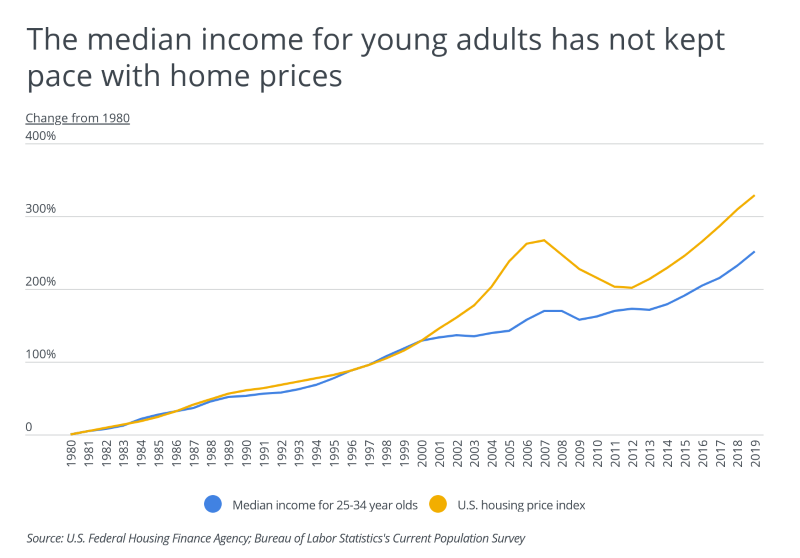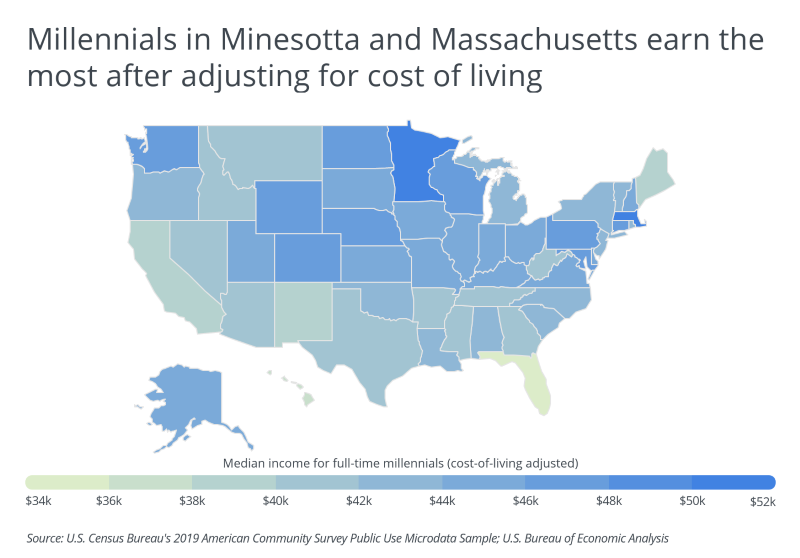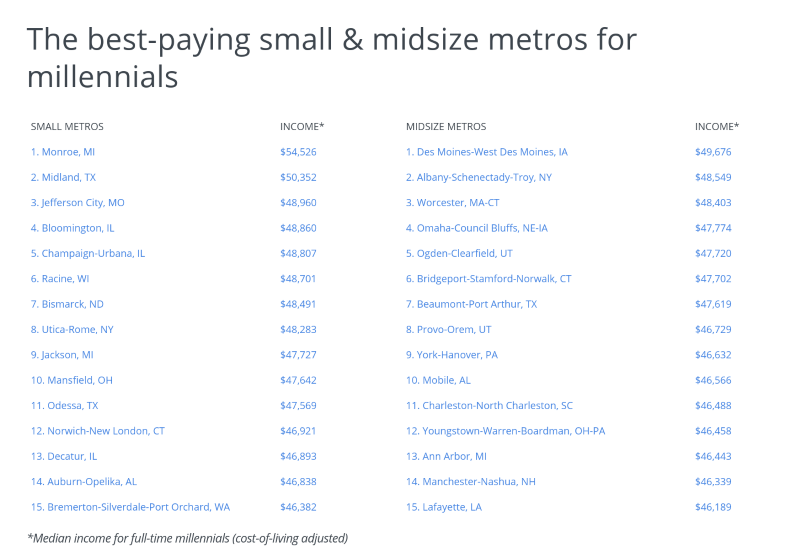The Best-Paying Cities for Millennials

November 16, 2020
Numbering over 72 million, millennials have surpassed Baby Boomers to be the largest living adult generation. Millennials, defined by the Pew Research Center as people born between 1981–1996, are now in their prime home-buying years. However, millennial homeownership rates have lagged that of older generations—in part, because while home prices have been rising, income has not kept pace. According to the latest data from the U.S. Census Bureau, median annual income for full-time working millennials was $42,000 in 2019, leaving many millennials struggling to afford a home.
Nationally, data from the Census Bureau shows that while the homeownership rate in the U.S. was 64.6% in 2019, the rate for millennials was just 39.9%. The median income for 25 to 34 year olds has increased 2.5-fold since 1980; however, housing prices have more than tripled over the same time period. Median income growth for that age group kept pace with housing prices until the year 2000 when housing prices began to rise more steeply. Although housing prices dropped significantly during the Great Recession, they have been rising rapidly since 2012.

At the state level, millennials living in Minnesota and Massachusetts had the highest median incomes after adjusting for cost of living, at $51,282 and $50,137 in 2019, respectively. Due to its very high cost of living, millennials living in Hawaii tend to earn less with a cost-of-living adjusted median income of $37,849 last year. The cost of living in Florida is about the same as the national average, but millennials in Florida earned just $34,990 in adjusted median income, the lowest in the country.

To find the best-paying cities for millennials, researchers at HireAHelper analyzed the latest data on income and home prices from the U.S. Census Bureau and Zillow. The researchers ranked metro areas according to the cost-of-living adjusted median income for full-time working millennials. Researchers also calculated the unadjusted median income for full-time millennials, the median home price, and the millennial homeownership rate.
To improve relevance, only metropolitan areas with at least 100,000 people were included in the analysis. Additionally, metro areas were grouped into the following cohorts based on population size:
- Small metros: 100,000–349,999
- Midsize metros: 350,000–999,999
- Large metros: 1,000,000 or more
Here are the metros with the highest median income for full-time millennials, after adjusting for cost of living.

The Best-Paying Large Metros for Millennials
 Photo Credit: Alamy Stock Photo
Photo Credit: Alamy Stock Photo15. Columbus, OH
- Median income for full-time millennials (cost-of-living adjusted): $46,790
- Median income for full-time millennials (unadjusted): $43,000
- Median home price: $223,010
- Millennial homeownership rate: 37.9%
- Cost of living: 8.1% below the national average
 Photo Credit: Alamy Stock Photo
Photo Credit: Alamy Stock Photo14. Baltimore-Columbia-Towson, MD
- Median income for full-time millennials (cost-of-living adjusted): $46,860
- Median income for full-time millennials (unadjusted): $50,000
- Median home price: $307,675
- Millennial homeownership rate: 44.3%
- Cost of living: 6.7% above the national average
 Photo Credit: Alamy Stock Photo
Photo Credit: Alamy Stock Photo13. Milwaukee-Waukesha, WI
- Median income for full-time millennials (cost-of-living adjusted): $47,489
- Median income for full-time millennials (unadjusted): $45,020
- Median home price: $200,213
- Millennial homeownership rate: 35.4%
- Cost of living: 5.2% below the national average
 Photo Credit: Alamy Stock Photo
Photo Credit: Alamy Stock Photo12. Denver-Aurora-Lakewood, CO
- Median income for full-time millennials (cost-of-living adjusted): $47,664
- Median income for full-time millennials (unadjusted): $50,000
- Median home price: $462,724
- Millennial homeownership rate: 42.9%
- Cost of living: 4.9% above the national average
 Photo Credit: Alamy Stock Photo
Photo Credit: Alamy Stock Photo11. St. Louis, MO-IL
- Median income for full-time millennials (cost-of-living adjusted): $47,967
- Median income for full-time millennials (unadjusted): $43,650
- Median home price: $188,845
- Millennial homeownership rate: 48.0%
- Cost of living: 9.0% below the national average
 Photo Credit: Alamy Stock Photo
Photo Credit: Alamy Stock Photo10. Kansas City, MO-KS
- Median income for full-time millennials (cost-of-living adjusted): $48,439
- Median income for full-time millennials (unadjusted): $45,000
- Median home price: $218,314
- Millennial homeownership rate: 43.9%
- Cost of living: 7.1% below the national average
 Photo Credit: Alamy Stock Photo
Photo Credit: Alamy Stock Photo9. Cincinnati, OH-KY-IN
- Median income for full-time millennials (cost-of-living adjusted): $48,667
- Median income for full-time millennials (unadjusted): $43,800
- Median home price: $201,822
- Millennial homeownership rate: 43.9%
- Cost of living: 10.0% below the national average
 Photo Credit: Alamy Stock Photo
Photo Credit: Alamy Stock Photo8. Minneapolis-St. Paul-Bloomington, MN-WI
- Median income for full-time millennials (cost-of-living adjusted): $48,733
- Median income for full-time millennials (unadjusted): $50,000
- Median home price: $307,156
- Millennial homeownership rate: 48.8%
- Cost of living: 2.6% above the national average
 Photo Credit: Alamy Stock Photo
Photo Credit: Alamy Stock Photo7. Hartford-East Hartford-Middletown, CT
- Median income for full-time millennials (cost-of-living adjusted): $48,972
- Median income for full-time millennials (unadjusted): $50,000
- Median home price: $246,266
- Millennial homeownership rate: 41.3%
- Cost of living: 2.1% above the national average
 Photo Credit: Alamy Stock Photo
Photo Credit: Alamy Stock Photo6. Washington-Arlington-Alexandria, DC-VA-MD-WV
- Median income for full-time millennials (cost-of-living adjusted): $50,934
- Median income for full-time millennials (unadjusted): $60,000
- Median home price: $455,038
- Millennial homeownership rate: 38.0%
- Cost of living: 17.8% above the national average
 Photo Credit: Alamy Stock Photo
Photo Credit: Alamy Stock Photo5. Pittsburgh, PA
- Median income for full-time millennials (cost-of-living adjusted): $51,557
- Median income for full-time millennials (unadjusted): $48,000
- Median home price: $172,719
- Millennial homeownership rate: 44.3%
- Cost of living: 6.9% below the national average
 Photo Credit: Alamy Stock Photo
Photo Credit: Alamy Stock Photo4. Boston-Cambridge-Newton, MA-NH
- Median income for full-time millennials (cost-of-living adjusted): $51,664
- Median income for full-time millennials (unadjusted): $59,000
- Median home price: $520,206
- Millennial homeownership rate: 35.4%
- Cost of living: 14.2% above the national average
 Photo Credit: Alamy Stock Photo
Photo Credit: Alamy Stock Photo3. Seattle-Tacoma-Bellevue, WA
- Median income for full-time millennials (cost-of-living adjusted): $51,727
- Median income for full-time millennials (unadjusted): $58,400
- Median home price: $555,689
- Millennial homeownership rate: 36.3%
- Cost of living: 2.9% above the national average
 Photo Credit: Alamy Stock Photo
Photo Credit: Alamy Stock Photo2. San Francisco-Oakland-Berkeley, CA
- Median income for full-time millennials (cost-of-living adjusted): $53,191
- Median income for full-time millennials (unadjusted): $70,000
- Median home price: $1,113,664
- Millennial homeownership rate: 25.0%
- Cost of living: 31.6% above the national average
 Photo Credit: Alamy Stock Photo
Photo Credit: Alamy Stock Photo1. San Jose-Sunnyvale-Santa Clara, CA
- Median income for full-time millennials (cost-of-living adjusted): $60,201
- Median income for full-time millennials (unadjusted): $77,900
- Median home price: $1,219,074
- Millennial homeownership rate: 26.6%
- Cost of living: 29.4% above the national average
Detailed Findings & Methodology
The best-paying metros for millennials are a diverse set, with a mix of high-cost coastal cities and more affordable cities in the Midwest. The top two best-paying large metro areas—San Jose and San Francisco—are some of the most expensive areas in the country, but millennials earn enough here to make up for the high cost of living. Because home prices in the Bay Area are disproportionately more expensive than the prices of other goods and services, homeownership rates still lag many of the best-paying metro areas with more affordable housing.
The best-paying small and midsize metros are similarly spread out across the country. Most of these metros boast affordability and lower home prices, meaning that millennials do not need to earn as much to live comfortably. Millennial homeownership rates tend to be higher in these metros as well. Overall, the millennial homeownership rate is close to 50 percent among the best-paying small and midsize metros.
To determine the best-paying cities for millennials, HireAHelper analyzed data from the U.S. Census Bureau's 2019 American Community Survey Public Use Microdata Sample (ACS PUMS), the Bureau of Economic Analysis's 2018 Regional Price Parity (RPP) dataset, and Zillow. Statistics on the median income for full-time millennial workers and the millennial home ownership rate are from the ACS PUMS, and the cost of living index is from the RPP. Median home prices come from the Zillow Home Value Index for September 2020.
To make income in expensive areas and cheaper areas comparable, median income for each metro was adjusted using the cost of living index for that metro. Income in expensive metros was adjusted down to reflect lower purchasing power while income in relatively affordable cities was adjusted up to reflect higher purchasing power.
Metro areas are ranked by the cost-of-living adjusted median income for full-time millennial workers. The Pew Research Center defines millennials as the generation of people born in 1981–1996, meaning millennials were 23 to 38 years old in 2019.
Only metropolitan areas with at least 100,000 people were included in the analysis. Additionally, metro areas were grouped into the following cohorts based on population size:
- Small metros: 100,000–349,999
- Midsize metros: 350,000–999,999
- Large metros: 1,000,000 or more